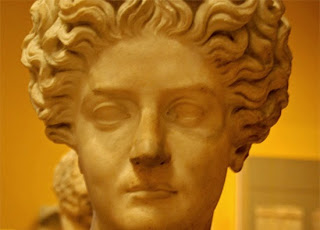In Brutus, a history of Roman oratory, Cicero provides examples of women (Lelia, her daughters -the Mucias- and her granddaughters -the Licinias-) who possessed an education and oratorical ability with which they could have become excellent orators, as used to happen with men of the same social status, if the exercise of judicial and political oratory had not been vetoed for Roman women. Cornelia, the mother of the Gracchi, also enjoyed an excellent preparation to pass it on to her children. Well into the first century BC, in an area of clear expansion of women's rights, three Roman matrons (Hortensia, Maesia and Gaia Afrania) practiced law.

Hortensia
Rome; 1st century BCE
Period of activity: 42 BCE — ?
Geographical classification: Europe > Italy
Socio-cultural movements
Antiquity > Roman culture > Republic
Groups by dedication
Writers > Orators
Writers > in > Latin
Context of feminine creation
Review
Hortensia was the daughter of Quintus Hortensius, a famous orator who had achieved great prestige in the Forum before Cicero's triumph.
In a context in which it was not possible for women to give speeches in court in defense of others nor to access to public positions (magistracies), Hortensia gave a speech in the forum in defense of the interests of Roman matrons, as she was one of them.
Activities
Justifications
Biography
Historical and social context: after the assassination of Julius Caesar, his heir, Octavian, formed the Second Triumvirate with Mark Antony and Lepidus, a political pact by which the power of Rome was divided among them. The triumvirs, wanting to avenge the death of Caesar, fought against the republicans. At the same time that they published the names of those who had been declared outlaws for participating in the assassination of Caesar, they drew up a list made up of 1,400 midwives who had to contribute money to be able to pay for the imminent war that was going to confront them with the Republicans.
Appian informs us that they established penalties for those who hid a part of their assets and even established rewards for those who reported these people. The response from those 1,400 women was immediate. They pleaded with the female relatives of the triumvirs, and the rejection of Fulvia, wife of the triumvir Mark Antony, was the event that provoked Hortensia's speech. Once in the Forum, they stood in front of the tribune of the triumvirs and Hortensia spoke on behalf of that group of matrons. She practiced as a lawyer to prevent that group of Roman women from having to pay the fee that had been imposed on them by the triumvirs. It was the year 42 BC and women were banned from exercising legal professions.
The classical information of primordial rank about Hortensia is found in three chapters of Appian's Roman History, which can be outlined somewhat more with the help of the interesting section of the Memorable Deeds and Sayings in which Valerius Maximus speaks of the three female Roman orators (Gaia Afrania, Maesia and Hortensia), as well as the allusions, only in passing, to Quintilian and Jerome.
Hortensia was the daughter of Quintus Hortensius Hortalus, the most prestigious orator in the period immediately preceding Cicero's triumph in the forum. This fact is important, in the first place, with regard to the education of Hortensia, who logically must have received the careful education that was to be expected from the daughter of a famous orator who, moreover, possessed enormous wealth. This is how Ronald Syme portrays him: "Hortensius, dominant in the courts of justice and in the Senate, flaunted luxury and a taste for a baroque style both in his life and in his oratory. Given to luxury, without taste or measure, the lawyer was famous for his generous life and for his dishonest earnings, for his winery, for his hunting ground and for his fishponds.”
Hortensia's education must not have lacked the influence of such a curious father. Valerius Maximus points out that Hortensia followed his style so closely that it seemed to revive him in her speech: "Quintus Hortensius then revived in his female offspring and inspired the words of his daughter; if his male offspring had wanted to imitate his strength, the great heritage of Hortensius's eloquence would not have been cut short by this single speech by a woman.”
Bibliography
-Appian, Historia romana II. Guerras civiles (books I-II). Translation into Spanish and notes by Antonio Sancho Royo (1985). Madrid: Gredos.
-Lopez, Aurora (1994). No sólo hilaron lana. Escritoras romanas en prosa y verso, Madrid: Ediciones Clásicas.
-Lopez, Aurora (1989). "La oratoria femenina en Roma a la luz de la actual", in La oratoria en Grecia y Roma: su vigencia en la actualidad, Universidad de verano de Teruel, Teruel, pp. 97-115.
-Lopez, Aurora, (1992). “Hortensia, primera oradora romana”. Florentia Iliberritana: revista de estudios de Antigüedad Clásica, 3, Granada, pp. 317-332.
-Valerio Máximo, Publio. Los nueve libros de hechos y dichos memorables. Edition in charge of Fernando Martín Acera (1988). Madrid: Akal.
Didactic approach
-Classical culture: Block Classical roots of today's world. Everyday life; Block Continuity of cultural heritage. Literature, art and science.
-Latin 4th ESO: Block Latin text and translation; Block Legacy and heritage; Block The present of Latin civilisation.
-Latin Baccalaureate: Literary Education Block.
-Universal Literature 1st Baccalaureate: Interpretation of fragments from the Roman period of different genres and themes.
-Spanish Language and Literature ESO: Literary Education Block.